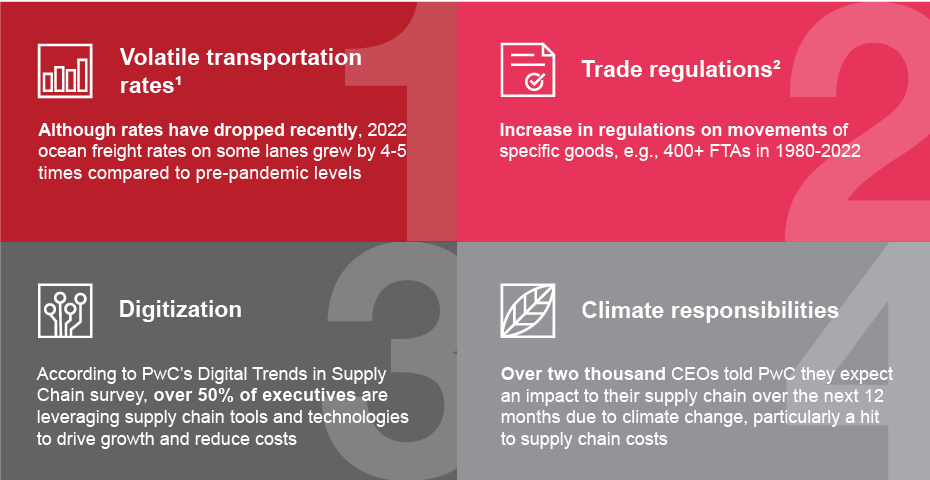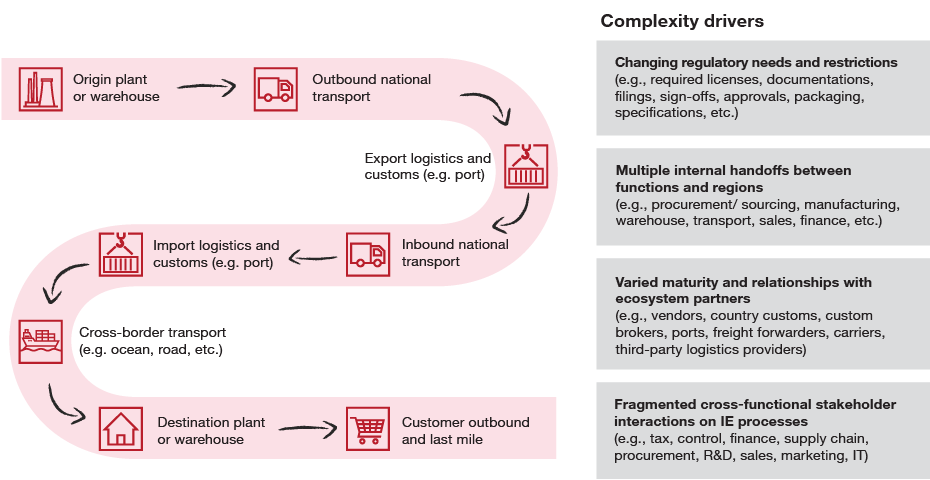Preparing the import-export function for the cyclical nature of the global trade market
Supply chain resilience has become one of the biggest boardroom topics in recent years. A global pandemic, the resulting bullwhip effect, congested ports, and talent wars created chaos for many operations leaders. Just when companies thought turbulent times were over, continued geopolitical uncertainty and fluctuating interest rates have further challenged supply chain risk management practices.
The interconnectedness of global value chains catalyzed growth and created opportunities for multinational companies. With the pace of globalization changing, and given increased regulation and the need for transparency, the urgency of continued reinvestments by companies with highly complex supply chain ecosystems is heightened. Against this background, this report provides a point of view, informed by program experience and research, on how organizations can prepare their import-export function for the unpredictable yet cyclical nature of the global trade market – and determine what approach best suits them.
Increasing import-export complexity with fluctuating global trends
Import-export (IE) is the trade in products, commodities, and information across sovereign borders with a commercial objective. The associated international logistics and customs clearance operations are integral components of managing the global value chains in consumer-packaged goods, pharmaceuticals, retail, and many other industries. The graphic below shows four external pressures that have increased the complexity of international trade over the past 2-5 years and put strains on IE operations.

The import-export value chain and management approaches
While the IE process is a multifaceted and intricate undertaking that involves various stages and stakeholders, a simplified ‘order-to-shelf’ view presents typical components of the IE process:

The complexity drivers, and the reliance on the broader ecosystem of IE service partners, necessitate careful planning, execution, and expert management of the processes. While companies are slowly beginning to think through the strategy behind their IE processes, the complexity of the IE process and the entire ecosystem makes it challenging to optimize operations in a straightforward manner. That, paired with the reliance on service partners, requires clear communications, accountability, and expectation-setting.
As multinational companies take distinct approaches to managing their IE operations, we prioritized three opportunities in a high-level framework to unlock value, depending on the maturity and the objectives of capability reinvention:
Externalized
Pragmatic approach mainly driven by day-to-day business needs and mostly executed/supported by external parties
Synchronized
Deliberate methodology to optimize the IE function for costs and make international trade flows compliant
Integrated
IE function as a competitive advantage through end-to-end supply chain optimization to generate bottom- and top-line benefits
Preparing for the inevitable fluctuations in global trade cycles with a future-fit and resilient import-export capability
There is no right or wrong approach, but a dedicated and intentional focus is needed to assess how existing capabilities fit with internal enterprise objectives and those of the strategic partners. As the post-pandemic firefighting effort dissipates, companies should use this time to figure out what is the most relevant play for them, based on considering the following questions:
- What is the scope of our customs, trade, and international logistics footprint today, and how do we see this changing based on our future portfolio, growth, and strategic aspirations?
- How do our operating philosophy, problem to solve, and business tolerances differ across markets and sectors?
- How can we integrate this IE approach into our existing operations capabilities, and what does the resulting operating approach look like in terms of structure, processes, tools and governance?
- Which areas can help us accelerate value realization by redesigning IE operations?
- What investments are a must now, and how are we set up to evolve these capabilities against our enterprise transformation roadmap?
Ultimately, maintaining compliance is non-negotiable, and not having the right product in front of the consumer is not sustainable. With continued uncertainty in the macroeconomic climate, those who are better placed to understand vulnerabilities in their operational ecosystem and invest wisely will be more likely to seize the opportunity, while navigating the challenges that lie ahead.
Stephanie Abi Abdallah, Matt McMahon, Meghan Munson Robertson and Xavier van Ardenne have also contributed to this report.

